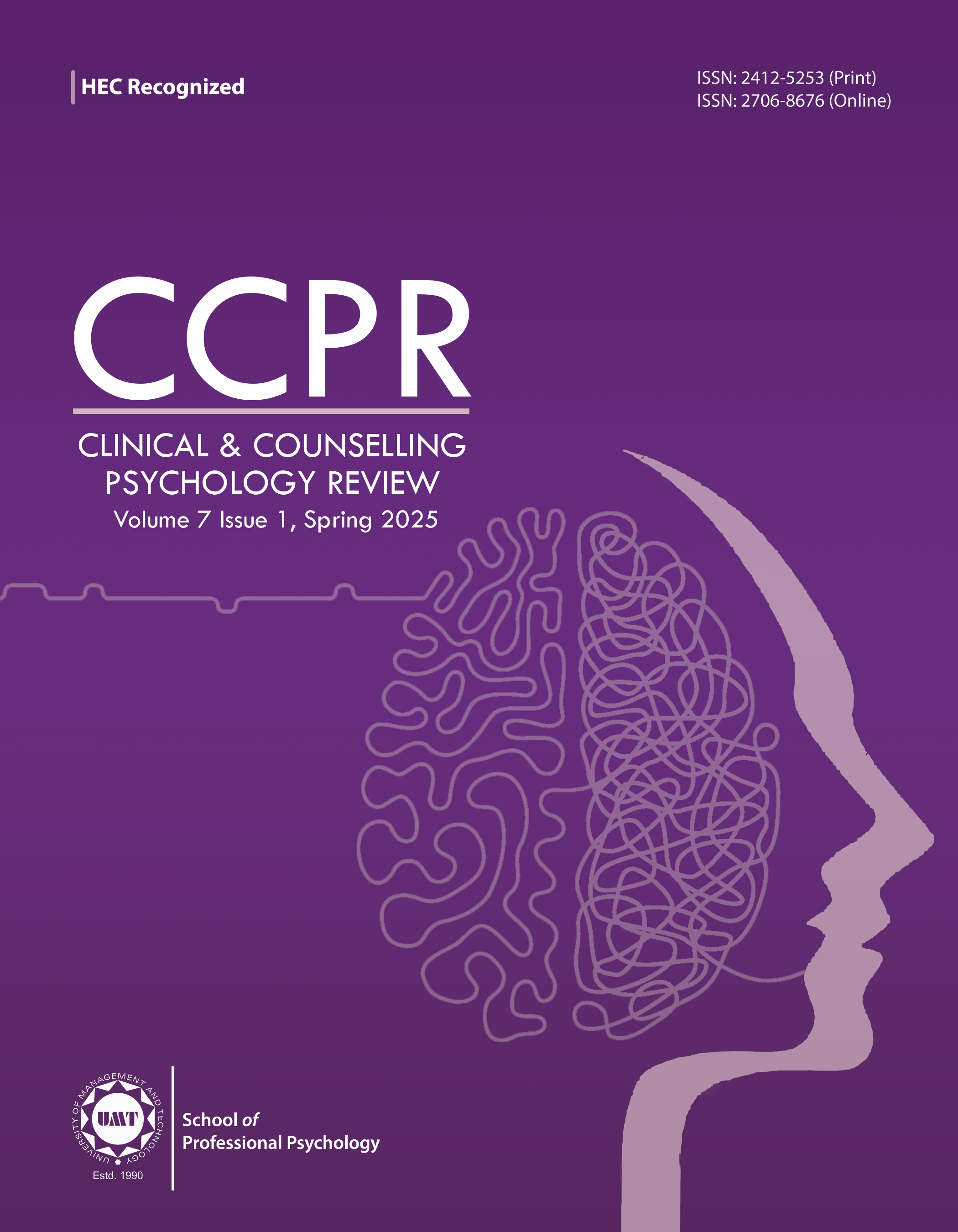Perceived Effects of Endometriosis on Married Women: A Qualitative Study
Abstract
 Abstract Views: 0
Abstract Views: 0
The current study aimed to explore the perceived effects of endometriosis on the lives of diagnosed married Muslim women residing in Lahore, Pakistan. Three semi-structured, in-depth interviews were conducted with gynecologists who had at least 10 years of experience. Moreover, six focus group discussions (FGDs) were conducted with women diagnosed with endometriosis, stratified into three distinct age groups: 18–24 years (Group 1), 25–34 years (Group 2), and 35 years and above (Group 3). For each age group, two FGDs were held, comprising four participants per session. Purposive sampling strategy was used to recruit participants for focus groups and interviews. Reflexive thematic analysis (Braun & Clarke, 2019) was conducted and four superordinate themes emerged. These included perceived physical effects, perceived psychological effects, perceived social effects, and perceived spiritual effects of endometriosis. Results were discussed in the light of previous literature and cultural background.
Downloads
References
Abulughod, N., Valakas, S., & El-Assaad, F. (2024). Dietary and nutritional interventions for the management of endometriosis. Nutrients, 16(23), Article e3988. https://doi.org/10.3390/nu16233988
Arab, A., Karimi, E., Vingrys, K., Rezaei Kelishadi, M., Mehrabani, S., & Askari, G. (2022). Food groups and nutrients consumption and risk of endometriosis: A systematic review and meta-analysis of observational studies. Nutrition Journal, 21, Article e58. https://doi.org/10.1186/s12937-022-00812-x
Benidir, A., Levert, M. J., & Bilodeau, K. (2023). The role of Islamic beliefs in facilitating acceptance of cancer diagnosis. Current Oncology, 30(9), 7789–7801. http://dx.doi.org/10.3390/curroncol30090565
Braun, V., & Clarke, V. (2019). Reflecting on reflexive thematic analysis. Qualitative Research in Sport, Exercise and Health, 11(4), 589–597. https://doi.org/10.1080/2159676X.2019.1628806
Chaman-Ara, K., Bahrami, M. A., & Bahrami, E. (2017). Endometriosis psychological aspects: A literature review. Journal of Endometriosis and Pelvic Pain Disorders, 9(2), 105–111. https://doi.org/10.5301/jeppd.5000276
Chiantera, V., Abesadze, E., & Mechsner, S. (2017). How to understand the complexity of endometriosis-related pain. Journal of Endometriosis and Pelvic Pain Disorders, 9(1), 30–38. https://doi.org/10.5301/je.5000271
Culley, L., Law, C., Hudson, N., Denny, E., Mitchell, H., Baumgarten, M., & Raine-Fenning, N. (2013). The social and psychological impact of endometriosis on women's lives: A critical narrative review. Human Reproduction Update, 19(6), 625–639. https://doi.org/10.1093/humupd/dmt027
De Graaff, A. A., D’Hooghe, T. M., Dunselman, G. A., Dirksen, C. D., Hummelshoj, L., & Simoens, S. (2013). The significant effect of endometriosis on physical, mental and social wellbeing: Results from an international cross-sectional survey. Human Reproduction, 28(10), 2677–2685. https://doi.org/10.1093/humrep/det284
Facchin, F., Barbara, G., Saita, E., Mosconi, P., Roberto, A., Fedele, L., & Vercellini, P. (2015). Impact of endometriosis on quality of life and mental health: Pelvic pain makes the difference. Journal of Psychosomatic Obstetrics & Gynecology, 36(4), 135–141. https://doi.org/10.3109/0167482x.2015.1074173
Facchin, F., Buggio, L., Vercellini, P., Frassineti, A., Beltrami, S., & Saita, E. (2021). Quality of intimate relationships, dyadic coping, and psychological health in women with endometriosis: Results from an online survey. Journal of Psychosomatic Research, 146, Article e110502. https://doi.org/10.1016/j.jpsychores.2021.110502
Falcone, T., & Flyckt, R. (2018). Clinical management of endometriosis. Obstetrics and Gynecology, 131(3), 557–571. https://doi.org/10.1097/AOG.0000000000002469
Ferreira-Valente, A., Sharma, S., Torres, S., Smothers, Z., Pais-Ribeiro, J., Abbott, J. H., & Jensen, M. P. (2019). Does religiosity/spirituality play a role in function, pain-related beliefs, and coping in women with chronic pain? A systematic review. Journal of Religion and Health, 61, 2331–2385. https://doi.org/10.1007/s10943-019-00914-7
Flores-Caldera, I., Ramos-Echevarría, P. M., Oliveras-Torres, J. A., Santos-Piñero, N., Rivera-Mudafort, E. D., Soto-Soto, D. M., Hernández-Colón, B., Rivera-Hiraldo, L. E., Mas, L., Rodríguez-Rabassa, M., Bracero, N. J., Rolla, E., & Ibero-American Endometriosis Association (2021). Ibero-American endometriosis patient phenome: Demographics, obstetric-gynecologic traits, and symptomatology. Frontiers in Reproductive Health, 3, Article e667345. https://doi.org/10.3389/frph.2021.667345
Forgeron, P. A., King, S., Stinson, J. N., McGrath, P. J., MacDonald, A. J., & Chambers, C. T. (2010). Social functioning and peer relationships in children and adolescents with chronic pain: A systematic review. Pain Research & Management, 15(1), 27–41. https://doi.org/10.1155/2010/820407
Gao, X., Yeh, Y. C., Outley, J., Simon, J., Botteman, M., & Spalding, J. (2006). Health-related quality of life burden of women with endometriosis: A literature review. Current Medical Research and Opinion, 22(9), 1787–1797. https://doi.org/10.1185/030079906x121084
Gatchel, R. J., Peng, Y. B., Peters, M. L., Fuchs, P. N., & Turk, D. C. (2007). The biopsychosocial approach to chronic pain: Scientific advances and future directions. Psychological Bulletin, 133(4), 581–624. https://doi.org/10.1037/0033-2909.133.4.581
Gica, N., Panaitescu, A. M., Iancu, G., Botezatu, R., Peltecu, G., & Gica, C. (2020). The role of biological markers in predicting infertility associated with non-obstructive endometriosis. Ginekologia Polska, 91(4), 189–192. https://doi.org/10.5603/gp.2020.0039
Harder, C., Velho, R. V., Brandes, I., Sehouli, J., & Mechsner, S. (2024). Assessing the true prevalence of endometriosis: A narrative review of literature data. International Journal of Gynaecology and Obstetrics, 167(3), 883–900. https://doi.org/10.1002/ijgo.15756
Hatala, A. R. (2012). The status of the "biopsychosocial" model in health psychology: Towards an integrated approach and a critique of cultural conceptions. Open Journal of Medical Psychology, 1(4), 71–79. https://doi.org/10.4236/ojmp.2012.14009
Hudson, N., Culley, L., Law, C., Mitchell, H., Denny, E., & Raine-Fenning, N. (2016). “We needed to change the mission statement of the marriage”: Biographical disruptions, appraisals and revisions among couples living with endometriosis. Sociology of Health & Illness, 38(5), 721–735. https://doi.org/10.1111/1467-9566.12392
Jones, G., Jenkinson, C., & Kennedy, S. (2004). The impact of endometriosis upon quality of life: A qualitative analysis. Journal of Psychosomatic Obstetrics & Gynecology, 25(2), 123–133. https://doi.org/10.1080/01674820400002279
Kainat., Pathan, N. F., Khuhro, B. N., Pir, S., Ghumro, R. A., Baloch, R., & Aqsa. (2024). Endometriosis and its consequences on fertility and quality of life – A hospital-based cross-sectional study at PMCH Nawabshah. Journal of Peoples University of Medical & Health Sciences Nawabshah, 14(4), 132–138. https://doi.org/10.46536/jpumhs/2024/14.04.570
Khan, Z. H., & Watson, P. J. (2006). Construction of the Pakistani Religious Coping Practices Scale: Correlations with religious coping, religious orientation, and reactions to stress among Muslim university students. International Journal for the Psychology of Religion, 16(2), 101–112. https://doi.org/10.1207/s15327582ijpr1602_2
Khawaja, U. B., Khawaja, A. A., Gowani, S. A., Shoukat, S., Ejaz, S., Ali, F. N., Rizvi, J., & Nawaz, F. H. (2009). Frequency of endometriosis among infertile women and association of clinical signs and symptoms with the laparoscopic staging of endometriosis. The Journal of the Pakistan Medical Association, 59(1), 30–34.
Lack of awareness blamed for prevalence of endometriosis. Dawn. https://www.dawn.com/news/1896865
Laganà, A. S., La Rosa, V. L., Rapisarda, A. M. C., Valenti, G., Sapia, F., Chiofalo, B., Rossetti, D., Frangež, H. B., Bokal, E. V., & Vitale, S. G. (2017). Anxiety and depression in patients with endometriosis: impact and management challenges. International Journal of Women S Health, 9, 323–330. https://doi.org/10.2147/ijwh.s119729
Manderson, L., Warren, N., & Markovic, M. (2008). Circuit breaking: Pathways of treatment seeking for women with endometriosis in Australia. Qualitative Health Research, 18(4), 522–534. https://doi.org/10.1177/1049732308315432
Mills, J., Shu, C., Misajon, R., & Rush-Privitera, G. (2023). ‘My body is out to wreck everything I have’: A qualitative study of how women with endometriosis feel about their bodies. Psychology & Health, 40(2), 285–303. https://doi.org/10.1080/08870446.2023.2218404
Mills, T. (2021, March 10). The spiritual cause of endometriosis. Energetic Wisdom. https://energetic-wisdom.co.uk/spiritual-causes-ofendometriosis/
Missmer, S. A., Tu, F. F., Agarwal, S. K., Chapron, C., Soliman, A. M., Chiuve, S., Eichner, S., Flores-Caldera, I., Horne, A. W., Kimball, A. B., Laufer, M. R., Leyland, N., Singh, S. S., Taylor, H. S., & As-Sanie, S. (2021). Impact of endometriosis on life-course potential: A narrative review. International Journal of General Medicine, 14, 9–25. https://doi.org/10.2147/IJGM.S261139
Moradi, M., Parker, M., Sneddon, A., Lopez, V., & Ellwood, D. (2014). Impact of endometriosis on women’s lives: A qualitative study. BMC Women’s Health, 14, Article e123. https://doi.org/10.1186/1472-6874-14-123/TABLES/3
Moradi, M., Parker, M., Sneddon, A., Lopez, V., & Ellwood, D. (2019). The Endometriosis Impact Questionnaire (EIQ): A tool to measure the long-term impact of endometriosis on different aspects of women’s lives. BMC Women's Health, 19(1), Article e64. https://doi.org/10.1186/s12905-019-0762-x
Naqvi, N., Imtiaz, R., Perveen, R., Khalid, S., Rafique, M., & Memon, H. A. (2022). Endometriosis in the Population of Kotri Pakistan: A cross sectional study. Pakistan Journal of Medical & Health Sciences, 16(1), 10124–1026. https://doi.org/10.53350/pjmhs221611024
Naseer-ud-Din, A. K., & Illahi, N. (2000). Prevalence and presentation of endometriosis in women admitted in Nishtar Hospital, Multan. Journal of Ayub Medical College Abbottabad, 12(3), 22–25.
Netzl, J., Gusy, B., Voigt, B., Sehouli, J., & Mechsner, S. (2023). Pain symptoms, sexual and mental health at the time of endometriosis diagnosis. Journal of endometriosis and pelvic pain disorders, 15(2), 72–81. https://doi.org/10.1177/22840265231179004
Nnoaham, K. E., Hummelshoj, L., Webster, P., D’Hooghe, T., De Cicco Nardone, F., De Cicco Nardone, C., Jenkinson, C., Kennedy, S. H., & Zondervan, K. T. (2011). Impact of endometriosis on quality of life and work productivity: a multicenter study across ten countries. Fertility and Sterility, 96(2), 366–373. https://doi.org/10.1016/j.fertnstert.2011.05.090
Polit, D. F., & Beck, C. T. (2017). Nursing research: Generating and assessing evidence for nursing practice (10th ed.). Lippincott, Williams & Wilkins.
Pontoppidan, K., Olovsson, M., & Grundström, H. (2023). Clinical factors associated with quality of life among women with endometriosis: A cross-sectional study. BMC Women's Health, 23(1), 551–559. https://doi.org/10.1186/s12905-023-02694-5
Rashidian, P., Amini-Salehi, E., Karami, S., Nezhat, C., & Nezhat, F. (2025). Exploring the association between dietary fruit intake and endometriosis: A systematic review and meta-analysis. Journal of Clinical Medicine, 14(4), Article e1246. https://doi.org/10.3390/jcm14041246
Roomaney, R., & Kagee, A. (2016). Coping strategies employed by women with endometriosis in a public health-care setting. Journal of Health Psychology, 21(10), 2259–2268. https://doi.org/10.1177/1359105315573447
Roomaney, R., & Kagee, A. (2018). Salient aspects of quality of life among women diagnosed with endometriosis: A qualitative study. Journal of Health Psychology, 23(7), 905–916. https://doi.org/10.1177/1359105316643069
Roudsari, R. L., & Allan, H. T. (2011). Women’s experiences and preferences in relation to infertility counselling: A multifaith dialogue. International Journal of Fertility & Sterility, 5(3), 158–167.
Saad, M., Rafiq, A., Jamil, A., Sarfraz, Z., Sarfraz, A., Robles-Velasco, K., & Cherrez-Ojeda, I. (2023). Addressing the endometriosis knowledge gap for improved clinical care-a cross-sectional pre- and post-educational-intervention study among Pakistani women. Healthcare, 11(6), Article e809. https://doi.org/10.3390/healthcare11060809
Shah, M. (2023, October 7). Endometriosis: Common but underdiagnosed: A condition affecting women's health. Pakistan Today. https://www.pakistantoday.com.pk/2023/10/07/endometriosis-common-but-underdiagnosed
Tahira, T., Niaz, A., & Khalid, A. (2019). Prevalence of endometriosis in women with subfertility. Annals of Punjab Medical College, 13(3), 226–228. https://doi.org/10.29054/apmc/2019.753
Van Niekerk, L., Weaver-Pirie, B., & Matthewson, M. (2019). Psychological interventions for endometriosis-related symptoms: A systematic review with narrative data synthesis. Archives of Women's Mental Health, 22(6), 723–735. https://doi.org/10.1007/s00737-019-00972-6
Vannuccini, S., Lazzeri, L., Orlandini, C., Morgante, G., Bifulco, G., Fagiolini, A., & Petraglia, F. (2018). Mental health, pain symptoms and systemic comorbidities in women with endometriosis: A cross-sectional study. Journal of Psychosomatic Obstetrics and Gynaecology, 39(4), 315–320. https://doi.org/10.1080/0167482x.2017.1386171
Vercellini, P., Meana, M., Hummelshoj, L., Somigliana, E., Vigano, P., & Fedele, L. (2011). Priorities for endometriosis research: A proposed focus on deep dyspareunia. Reproductive Sciences, 18(2), 114–118. https://doi.org/10.1177/1933719110382921
Wen, X., Xiong, Y., Qu, X., Jin, L., Zhou, C., Zhang, M., & Zhang, Y. (2019). The risk of endometriosis after exposure to endocrine-disrupting chemicals: A meta-analysis of 30 epidemiology studies. Gynecological Endocrinology, 35(8), 645–650. https://doi.org/10.1080/09513590.2019.1590546








